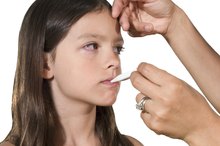What does fact checked mean?
At Healthfully, we strive to deliver objective content that is accurate and up-to-date. Our team periodically reviews articles in order to ensure content quality. The sources cited below consist of evidence from peer-reviewed journals, prominent medical organizations, academic associations, and government data.
- Allergies. (2018).
- Coman G., et al. (2014). Textile allergic contact dermatitis: Current status.
- Coman G., et al. (2014). Textile allergic contact dermatitis: Current status.
- Malinauskiene L, et al. (2013). Contact allergy from disperse dyes in textiles: A review.
- Malinauskiene L, et al. (2013). Contact allergy from disperse dyes in textiles: A review.
- Martin BG. (1999). Contact dermatitis: Evaluation and treatment.
- Martin BG. (1999). Contact dermatitis: Evaluation and treatment.
- Nelson JL, et al. (2010). Allergic contact dermatitis: Patch testing beyond the TRUE test.
- Nelson JL, et al. (2010). Allergic contact dermatitis: Patch testing beyond the TRUE test.
The information contained on this site is for informational purposes only, and should not be used as a substitute for the advice of a professional health care provider. Please check with the appropriate physician regarding health questions and concerns. Although we strive to deliver accurate and up-to-date information, no guarantee to that effect is made.
Allergic Reaction to Bed Sheets
An allergic reaction to bed sheets is most likely an allergic reaction to dust mites, according to the American College of Allergy, Asthma and Immunology. While someone can have an allergic reaction to certain detergents and fragrances used to laundering products, the most common cause is dust mites. **An allergic reaction to bed sheets is identifiable and treatable by seeing an allergist 2. An allergist can confirm and offer a professional diagnosis.
About
Bed sheets and other bedding are among the most common places dust mites are found, according to the Mayo Clinic. Dust mites are microscopic creatures that thrive in warm, humid fabric environments. If someone doesn’t change or wash her bed sheets on a regular basis, dust mites can infest the bedding. One who is allergic to dust mites will experience the same symptoms every time he is exposed to bed sheets containing dust mites.
- Bed sheets and other bedding are among the most common places dust mites are found, according to the Mayo Clinic.
- If someone doesn’t change or wash her bed sheets on a regular basis, dust mites can infest the bedding.
Cause
Allergy to Cardboard
Learn More
Someone who is allergic to dust mites, has a hypersensitivity to the proteins found in dust mite byproducts, according to MedlinePlus. When the body comes in contact with dust mites it recognizes the substance as a harmful threat to the body and tries to fight it off by producing IgE antibodies and histamine. This chemical release in the body results in common allergy symptoms.
Symptoms
The most common symptom affects the nasal passages, the eyes and the lungs, according to the Mayo Clinic. The sinus cavity becomes inflamed, causing nasal congestion, sneezing and nasal discharge. The swollen sinuses will also create pressure throughout the head, leading to facial pressure and sinus headaches. The eyes become irritated, red and can swell from a dust mite allergy 4. Those with allergy-induced asthma can experience shortness of breath, chest tightness and difficulty breathing.
- The most common symptom affects the nasal passages, the eyes and the lungs, according to the Mayo Clinic.
- The sinus cavity becomes inflamed, causing nasal congestion, sneezing and nasal discharge.
Treatment
Signs & Symptoms of Throat Allergies
Learn More
Eliminate dust mites to alleviate symptoms of an allergic reaction to bed sheets. Strip the bed of all bedding and wash it on a weekly basis in soapy water, over 130 degrees. Dry cleaning will also kill dust mites. Cover the mattress and pillows with dust mite covers that prevent mites from colonizing. Keep excessive stuffed animals or throw pillows off the bedding area to prevent dust mites from reappearing.
- Eliminate dust mites to alleviate symptoms of an allergic reaction to bed sheets.
- Cover the mattress and pillows with dust mite covers that prevent mites from colonizing.
Diagnosing
An allergic reaction to bed sheets may the sign of a different condition and needs to be evaluated and tested by an allergist 6. If symptoms do not improve after implementing home treatments, talk to a doctor about possible medications that can be used to treat the allergy symptoms.
Related Articles
References
- Allergies. (2018).
- Coman G., et al. (2014). Textile allergic contact dermatitis: Current status.
- Hurwitz M. (2017). Are you at risk for contact dermatitis?
- Malinauskiene L, et al. (2013). Contact allergy from disperse dyes in textiles: A review.
- Martin BG. (1999). Contact dermatitis: Evaluation and treatment.
- Nelson JL, et al. (2010). Allergic contact dermatitis: Patch testing beyond the TRUE test.
- American Lung Association. Dust mites. Updated July 1, 2019.
- Nelson HS. Immunotherapy for house-dust mite allergy. Allergy Asthma Proc. 2018;39(4):264-272. doi:10.2500/aap.2018.39.4145
- Kim JY, Rhee CS, Cho SH, Choe G, Kim DY, Han DH. House dust mite sublingual immunotherapy in children versus adults with allergic rhinitis. Published online ahead of print, 2020 Jun 13. Am J Rhinol Allergy. 2020;1945892420931713. doi:10.1177/1945892420931713
- Asthma and Allergy Foundation of America. Dust mite allergy. Updated October 2015.
- Babe KS Jr, Arlian LG, Confer PD, Kim R. House dust mite (Dermatophagoides farinae and Dermatophagoides pteronyssinus) prevalence in the rooms and hallways of a tertiary care hospital. J Allergy Clin Immunol. 1995;95(4):801-805. doi:10.1016/s0091-6749(95)70121-4
- Illinois Department of Public Health. Mites affecting humans.
- Lee E, Lee SY, Park MJ, Hong SJ. TNF-α (rs1800629) polymorphism modifies the effect of sensitization to house dust mite on asthma and bronchial hyperresponsiveness in children. Published online ahead of print, 2020 May 20. Exp Mol Pathol. 2020;115:104467. doi:10.1016/j.yexmp.2020.104467
- Boberg E, Johansson K, Malmhäll C, Weidner J, Rådinger M. House Dust Mite Induces Bone Marrow IL-33-Responsive ILC2s and TH Cells. Int J Mol Sci. 2020;21(11):E3751. Published 2020 May 26. doi:10.3390/ijms21113751
- Weitzel T, Makepeace BL, Elliott I, Chaisiri K, Richards AL, Newton PN. Marginalized mites: Neglected vectors of neglected diseases. PLoS Negl Trop Dis. 2020 Jul 23;14(7):e0008297. doi: 10.1371/journal.pntd.0008297. PMID: 32701946; PMCID: PMC7377360.
- Atta AH, Amer RM, Mesbah AE, Khater MW. Sublingual Versus Subcutaneous Immunotherapy as regards Efficacy and Safety in Respiratory Allergic Patients. Egypt J Immunol. 2019;26(2):65-78.
- American Lung Association. Dust mites. Updated July 1, 2019.
Writer Bio
Diane Marks started her writing career in 2010 and has been in health care administration for more than 30 years. She holds a registered nurse license from Citizens General Hospital School of Nursing, a Bachelor of Arts in health care education from California University of Pennsylvania and a Master of Science in health administration from the University of Pittsburgh.






